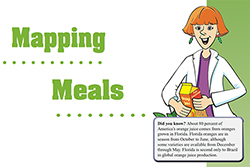Agricultural Literacy Curriculum Matrix
Companion Resource

Mapping Meals Activity
A 20-minute activity to illustrate to students that many of our foods come from around the world. Activity can be added to any lesson on food, food sources, nutrition, etc.
Time to Complete
20 minutes
Procedures
Preparation: Ask students to bring in orange juice containers from home. These can be bottles, cartons, or cans from concentrate.
Introducing the Activity: Farmers around the world grow the food we enjoy every day. There are three basic steps to get food from the farm to the dinner table:
- Production involves growing the food on a farm.
- Processing is what happens to the food once it is ready to be picked. This is when oranges are juiced and the juice is put in a carton or bottle and juice from concentrate is put in a can.
- Transportation involves taking the food to the store.
Activity: Display the orange juice containers for the students to observe. Point out the word "concentrate" on some of the containers.
- Ask students:
- What is the difference between regular juice and juice concentrate? Allow time for some quick research if necessary.
- The difference is how the fruit is processed. Juice that is not from concentrate means the fruit is squeezed and strained; then the juice is pasteurized, blended, and chilled. Finally, the juice is packaged in cartons. Juice from concentrate means the fruit is squeezed and much of the water is evaporated. The juice is pasteurized and canned for sale.
- What does pasteurized mean? Why is it important?
-
- Pasteurization is the process of heating the juice to a high temperature for a short amount of time to kill any harmful bacteria, which helps ensure food safety. As the juice is pasteurized, some natural orange components may become separated; then, after pasteurization, orange oil or orange pulp may be added back into the juice.
- What is the difference between regular juice and juice concentrate? Allow time for some quick research if necessary.
- Ask students to read the food labels and point out which labels mention “pasteurization.” Ask students:
- In what state or country was the orange juice made? Record all the observations on the board.
- Break the class into small groups. Have them research the locations and climates of the states and countries where the orange juice came from.
- Discuss the students’ findings and label the various states and countries on blank maps. Calculate the distance that the orange juice was shipped to get to your town. Ask students:
- What do the places where oranges are grown have in common?
- They are warm places where it doesn’t get too cold at night and where frost isn’t prevalent. Different types of oranges grow in different places.
- What is the farthest distance from where the orange juice was made to your school? The closest?
- What do the places where oranges are grown have in common?
Author
Alliance to Feed the Future
Sources
Text and design by The Education Center, LLC. This curriculum was developed, in part, by a grant from Farm Credit. Copyright 2013
Lessons Associated with this Resource
- Fruits of Our Labor
- Who Grew My Soup? (Grades K-2)
- Cultures, Food, and Communities Around the World (Grades K-2)
- Give Me Five!
- By Land, Air, or Sea
- FoodMASTER: Meal Management
- Who Grew My Soup? (Grades 3-5)
- Food Miles
- Growing Our State History (Grades 3-5)
- Culinary Concepts
- Nutrients to Get More Of (Grades 6-8)
- Nutrients to Get More Of (Grades 9-12)
